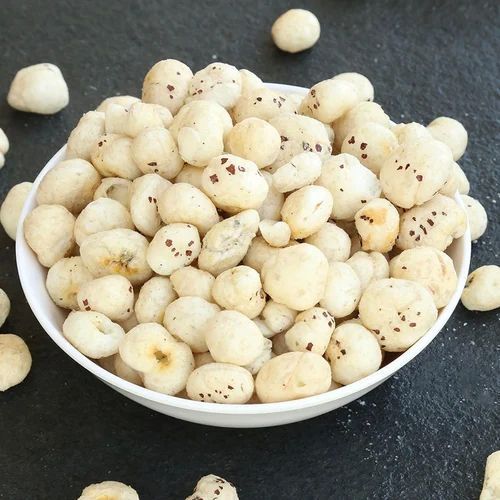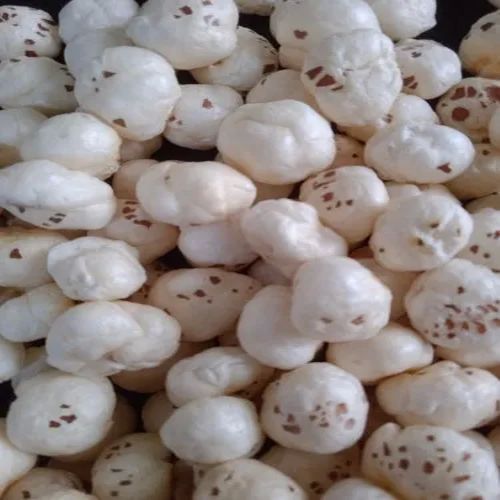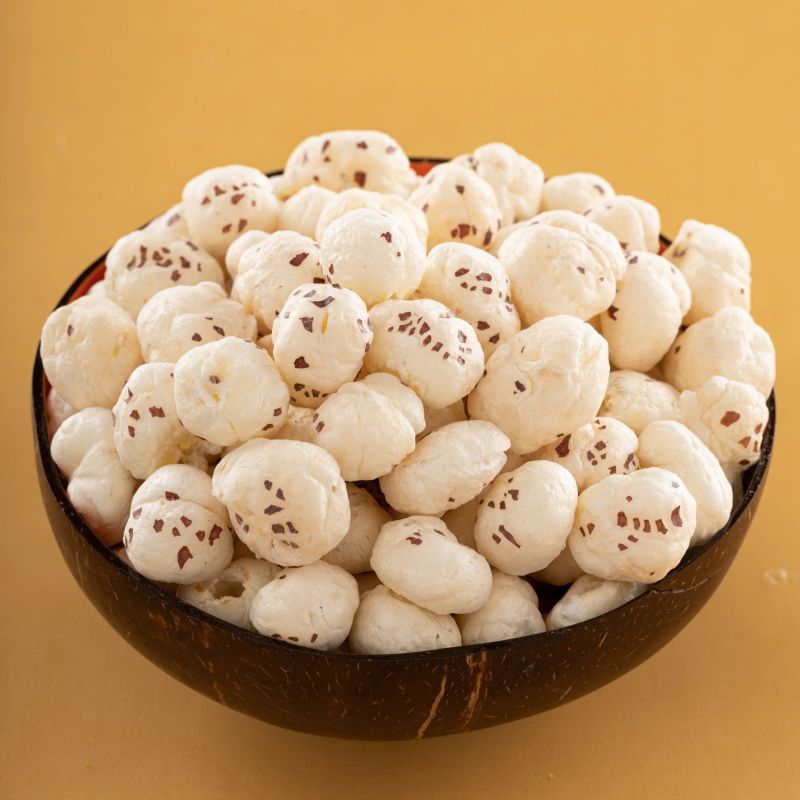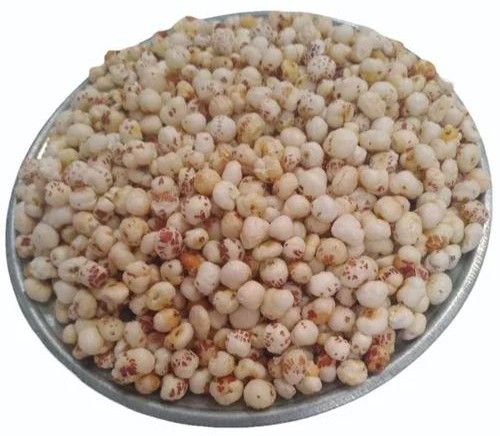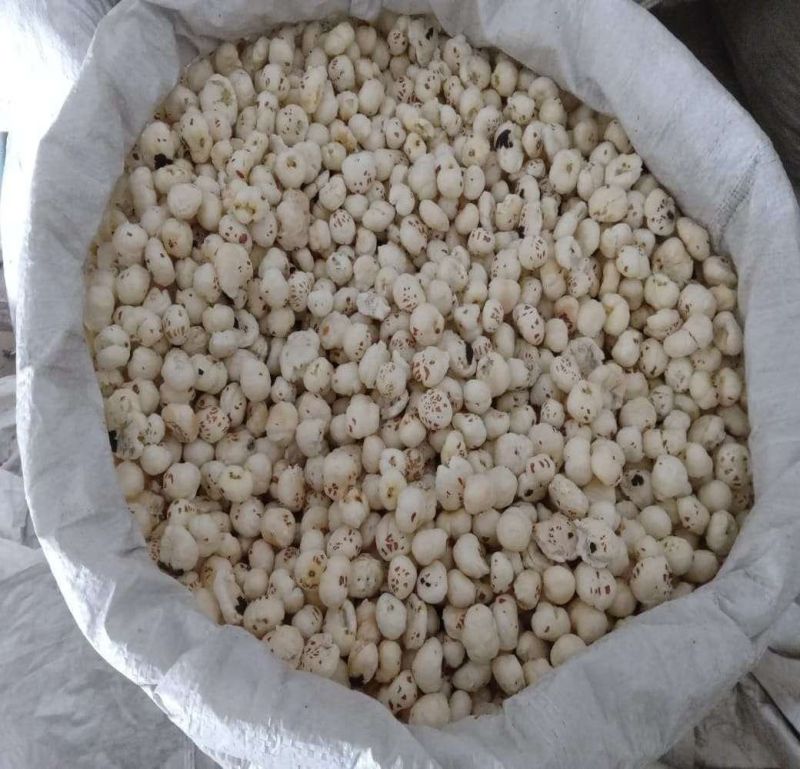nitin@vertexusglobal.com - GST NO. : 19ABAFV5939N1ZD
- Send Email
Raw Makhana
Leading Exporters, Wholesaler and Trader of 3 Suta Makhana, 4 Plus Suta Makhana, 4 Suta Makhana, 4.5 Suta Makhana, 5 Plus Suta Makhana, 5 Suta Makhana, 6 Plus Suta Makhana, Lawa Makhana, Murra Makhana and Turri Makhana from Kolkata.
| Business Type | Exporter, Supplier, Trader |
| Size | 3 Suta |
| Type | Raw |
| Color | White |
| Storage | Dry Place |
| Style | Dried |
| Shelf Life | 1 Years |
| Grade Standard | A Grade |
| Country of Origin | India |
Makhana a king of snacks category globally. Makhana (Foxnut), also known as Gorgon Nut, is grown in India, of which, Bihar is known for cultivating 92% of the production of Makhana in the world.. It comes from the lotus seeds. Foxnut (Makhana) can be mixed with vegetables, popped like corn and made into yummy porridge. Makhana has been proven to be high nutrients food which is rich in medicinal properties and good for daily health diet. The nutrients contained are vitamin, minerals and fibers. Low in fat and high in carbohydrates which makes it nutritionally distinct from other nuts. Highly rich in protein, carbohydrates, fibre, magnesium, potassium, phosphorus, iron and zinc. Better than dry fruits like almonds, walnuts, coconut and cashews in terms of sugar, protein, ascorbic acid and phenol content.
Significantly lower in the glycaemic index than most high carbohydrate foods like rice or bread. Known to contain kaempferol, a natural flavonoid also found in coffee (which prevents inflammation and ageing) and are high on phyto-nutrients (disease fighting nutrients) including alkaloids, gallic acid, saponins. 100 grams Makhana (fox nuts) contains 350 calories from which 308 calories come from carbohydrates and 39 calories from protein content. It has an insignificant amount of fats and no trans-fat. Moreover, it is high in potassium and provides a little amount of calcium.
Health Benefits of Makhana :
- Weight Management: Low in calories and high in fiber and protein, making it a filling snack that promotes satiety.
- Digestive Health: Rich fiber content supports a healthy digestive tract.
- Heart Health: Contains potassium and antioxidants that help regulate blood pressure and protect against heart issues.
- Blood Sugar Regulation: Its low glycemic index releases energy slowly, preventing blood sugar spikes and helping control hunger.
- Muscle and Nerve Support: Magnesium and thiamine aid in muscle function and cognitive health.
- Antioxidant Properties: Contains antioxidants like kaempferol, which fight inflammation and aging.
Culinary Applications
- Snacking: Makhana seeds are often roasted and seasoned with spices to make a healthy and tasty snack.
- Curries and Gravies: They can be added to curries and gravies for an extra crunch and nutrition.
- Sweets: Makhana seeds are used in various Indian sweets and desserts, such as kheer (a type of rice pudding).
- Salads: can be added to salads for a crunchy texture and added nutritional value.
Key Nutrients in 100g of Makhana :
- Calories: ~350 kcal
- Carbohydrates: ~75-77 g
- Protein: ~9-10 g
- Fiber: ~7-8 g
- Fat: <1 g
- Magnesium: ~90 mg
- Potassium: ~500 mg
- Phosphorus: ~200 mg
- Calcium: ~60-70 mg
- Iron: ~1.4 mg
| Business Type | Exporter, Supplier, Trader |
| Country of Origin | India |
| Grade Standard | A Grade |
| Shelf Life | 1 Years |
| Style | Dried |
| Storage | Dry Place |
| Color | White |
| Type | Raw |
| Size | 4 Plus Suta |
Makhana a king of snacks category globally. Makhana (Foxnut), also known as Gorgon Nut, is grown in India, of which, Bihar is known for cultivating 92% of the production of Makhana in the world.. It comes from the lotus seeds. Foxnut (Makhana) can be mixed with vegetables, popped like corn and made into yummy porridge. Makhana has been proven to be high nutrients food which is rich in medicinal properties and good for daily health diet. The nutrients contained are vitamin, minerals and fibers. Low in fat and high in carbohydrates which makes it nutritionally distinct from other nuts. Highly rich in protein, carbohydrates, fibre, magnesium, potassium, phosphorus, iron and zinc. Better than dry fruits like almonds, walnuts, coconut and cashews in terms of sugar, protein, ascorbic acid and phenol content.
Significantly lower in the glycaemic index than most high carbohydrate foods like rice or bread. Known to contain kaempferol, a natural flavonoid also found in coffee (which prevents inflammation and ageing) and are high on phyto-nutrients (disease fighting nutrients) including alkaloids, gallic acid, saponins. 100 grams Makhana (fox nuts) contains 350 calories from which 308 calories come from carbohydrates and 39 calories from protein content. It has an insignificant amount of fats and no trans-fat. Moreover, it is high in potassium and provides a little amount of calcium.
Health Benefits of Makhana :
- Weight Management: Low in calories and high in fiber and protein, making it a filling snack that promotes satiety.
- Digestive Health: Rich fiber content supports a healthy digestive tract.
- Heart Health: Contains potassium and antioxidants that help regulate blood pressure and protect against heart issues.
- Blood Sugar Regulation: Its low glycemic index releases energy slowly, preventing blood sugar spikes and helping control hunger.
- Muscle and Nerve Support: Magnesium and thiamine aid in muscle function and cognitive health.
- Antioxidant Properties: Contains antioxidants like kaempferol, which fight inflammation and aging.
Culinary Applications
- Snacking: Makhana seeds are often roasted and seasoned with spices to make a healthy and tasty snack.
- Curries and Gravies: They can be added to curries and gravies for an extra crunch and nutrition.
- Sweets: Makhana seeds are used in various Indian sweets and desserts, such as kheer (a type of rice pudding).
- Salads: can be added to salads for a crunchy texture and added nutritional value.
Key Nutrients in 100g of Makhana :
- Calories: ~350 kcal
- Carbohydrates: ~75-77 g
- Protein: ~9-10 g
- Fiber: ~7-8 g
- Fat: <1 g
- Magnesium: ~90 mg
- Potassium: ~500 mg
- Phosphorus: ~200 mg
- Calcium: ~60-70 mg
- Iron: ~1.4 mg
| Business Type | Exporter, Supplier, Trader |
| Size | 4 Suta |
| Type | Raw |
| Color | White |
| Storage | Dry Place |
| Shelf Life | 1 Years |
| Grade Standard | A Grade |
| Country of Origin | India |
Makhana a king of snacks category globally. Makhana (Foxnut), also known as Gorgon Nut, is grown in India, of which, Bihar is known for cultivating 92% of the production of Makhana in the world.. It comes from the lotus seeds. Foxnut (Makhana) can be mixed with vegetables, popped like corn and made into yummy porridge. Makhana has been proven to be high nutrients food which is rich in medicinal properties and good for daily health diet. The nutrients contained are vitamin, minerals and fibers. Low in fat and high in carbohydrates which makes it nutritionally distinct from other nuts. Highly rich in protein, carbohydrates, fibre, magnesium, potassium, phosphorus, iron and zinc. Better than dry fruits like almonds, walnuts, coconut and cashews in terms of sugar, protein, ascorbic acid and phenol content.
Significantly lower in the glycaemic index than most high carbohydrate foods like rice or bread. Known to contain kaempferol, a natural flavonoid also found in coffee (which prevents inflammation and ageing) and are high on phyto-nutrients (disease fighting nutrients) including alkaloids, gallic acid, saponins. 100 grams Makhana (fox nuts) contains 350 calories from which 308 calories come from carbohydrates and 39 calories from protein content. It has an insignificant amount of fats and no trans-fat. Moreover, it is high in potassium and provides a little amount of calcium.
Health Benefits of Makhana :
- Weight Management: Low in calories and high in fiber and protein, making it a filling snack that promotes satiety.
- Digestive Health: Rich fiber content supports a healthy digestive tract.
- Heart Health: Contains potassium and antioxidants that help regulate blood pressure and protect against heart issues.
- Blood Sugar Regulation: Its low glycemic index releases energy slowly, preventing blood sugar spikes and helping control hunger.
- Muscle and Nerve Support: Magnesium and thiamine aid in muscle function and cognitive health.
- Antioxidant Properties: Contains antioxidants like kaempferol, which fight inflammation and aging.
Culinary Applications
- Snacking: Makhana seeds are often roasted and seasoned with spices to make a healthy and tasty snack.
- Curries and Gravies: They can be added to curries and gravies for an extra crunch and nutrition.
- Sweets: Makhana seeds are used in various Indian sweets and desserts, such as kheer (a type of rice pudding).
- Salads: can be added to salads for a crunchy texture and added nutritional value.
Key Nutrients in 100g of Makhana :
- Calories: ~350 kcal
- Carbohydrates: ~75-77 g
- Protein: ~9-10 g
- Fiber: ~7-8 g
- Fat: <1 g
- Magnesium: ~90 mg
- Potassium: ~500 mg
- Phosphorus: ~200 mg
- Calcium: ~60-70 mg
- Iron: ~1.4 mg
| Business Type | Exporter, Supplier, Trader |
| Size | 4.5 Suita |
| Type | Raw |
| Color | White |
| Storage | Dry Place |
| Style | Dried |
| Shelf Life | 1 Years |
| Grade Standard | A Grade |
| Country of Origin | India |
Makhana a king of snacks category globally. Makhana (Foxnut), also known as Gorgon Nut, is grown in India, of which, Bihar is known for cultivating 92% of the production of Makhana in the world.. It comes from the lotus seeds. Foxnut (Makhana) can be mixed with vegetables, popped like corn and made into yummy porridge. Makhana has been proven to be high nutrients food which is rich in medicinal properties and good for daily health diet. The nutrients contained are vitamin, minerals and fibers. Low in fat and high in carbohydrates which makes it nutritionally distinct from other nuts. Highly rich in protein, carbohydrates, fibre, magnesium, potassium, phosphorus, iron and zinc. Better than dry fruits like almonds, walnuts, coconut and cashews in terms of sugar, protein, ascorbic acid and phenol content.
Significantly lower in the glycaemic index than most high carbohydrate foods like rice or bread. Known to contain kaempferol, a natural flavonoid also found in coffee (which prevents inflammation and ageing) and are high on phyto-nutrients (disease fighting nutrients) including alkaloids, gallic acid, saponins. 100 grams Makhana (fox nuts) contains 350 calories from which 308 calories come from carbohydrates and 39 calories from protein content. It has an insignificant amount of fats and no trans-fat. Moreover, it is high in potassium and provides a little amount of calcium.
Health Benefits of Makhana :
- Weight Management: Low in calories and high in fiber and protein, making it a filling snack that promotes satiety.
- Digestive Health: Rich fiber content supports a healthy digestive tract.
- Heart Health: Contains potassium and antioxidants that help regulate blood pressure and protect against heart issues.
- Blood Sugar Regulation: Its low glycemic index releases energy slowly, preventing blood sugar spikes and helping control hunger.
- Muscle and Nerve Support: Magnesium and thiamine aid in muscle function and cognitive health.
- Antioxidant Properties: Contains antioxidants like kaempferol, which fight inflammation and aging.
Culinary Applications
- Snacking: Makhana seeds are often roasted and seasoned with spices to make a healthy and tasty snack.
- Curries and Gravies: They can be added to curries and gravies for an extra crunch and nutrition.
- Sweets: Makhana seeds are used in various Indian sweets and desserts, such as kheer (a type of rice pudding).
- Salads: can be added to salads for a crunchy texture and added nutritional value.
Key Nutrients in 100g of Makhana :
- Calories: ~350 kcal
- Carbohydrates: ~75-77 g
- Protein: ~9-10 g
- Fiber: ~7-8 g
- Fat: <1 g
- Magnesium: ~90 mg
- Potassium: ~500 mg
- Phosphorus: ~200 mg
- Calcium: ~60-70 mg
- Iron: ~1.4 mg
| Business Type | Exporter, Supplier, Trader |
| Country of Origin | India |
| Grade Standard | A Grade |
| Style | Dried |
| Storage | Dry Place |
| Color | White |
| Type | Raw |
| Size | 5 Plus Suta |
Makhana a king of snacks category globally. Makhana (Foxnut), also known as Gorgon Nut, is grown in India, of which, Bihar is known for cultivating 92% of the production of Makhana in the world.. It comes from the lotus seeds. Foxnut (Makhana) can be mixed with vegetables, popped like corn and made into yummy porridge. Makhana has been proven to be high nutrients food which is rich in medicinal properties and good for daily health diet. The nutrients contained are vitamin, minerals and fibers. Low in fat and high in carbohydrates which makes it nutritionally distinct from other nuts. Highly rich in protein, carbohydrates, fibre, magnesium, potassium, phosphorus, iron and zinc. Better than dry fruits like almonds, walnuts, coconut and cashews in terms of sugar, protein, ascorbic acid and phenol content.
Significantly lower in the glycaemic index than most high carbohydrate foods like rice or bread. Known to contain kaempferol, a natural flavonoid also found in coffee (which prevents inflammation and ageing) and are high on phyto-nutrients (disease fighting nutrients) including alkaloids, gallic acid, saponins. 100 grams Makhana (fox nuts) contains 350 calories from which 308 calories come from carbohydrates and 39 calories from protein content. It has an insignificant amount of fats and no trans-fat. Moreover, it is high in potassium and provides a little amount of calcium.
Health Benefits of Makhana :
- Weight Management: Low in calories and high in fiber and protein, making it a filling snack that promotes satiety.
- Digestive Health: Rich fiber content supports a healthy digestive tract.
- Heart Health: Contains potassium and antioxidants that help regulate blood pressure and protect against heart issues.
- Blood Sugar Regulation: Its low glycemic index releases energy slowly, preventing blood sugar spikes and helping control hunger.
- Muscle and Nerve Support: Magnesium and thiamine aid in muscle function and cognitive health.
- Antioxidant Properties: Contains antioxidants like kaempferol, which fight inflammation and aging.
Culinary Applications
- Snacking: Makhana seeds are often roasted and seasoned with spices to make a healthy and tasty snack.
- Curries and Gravies: They can be added to curries and gravies for an extra crunch and nutrition.
- Sweets: Makhana seeds are used in various Indian sweets and desserts, such as kheer (a type of rice pudding).
- Salads: can be added to salads for a crunchy texture and added nutritional value.
Key Nutrients in 100g of Makhana :
- Calories: ~350 kcal
- Carbohydrates: ~75-77 g
- Protein: ~9-10 g
- Fiber: ~7-8 g
- Fat: <1 g
- Magnesium: ~90 mg
- Potassium: ~500 mg
- Phosphorus: ~200 mg
- Calcium: ~60-70 mg
- Iron: ~1.4 mg
| Business Type | Exporter, Supplier, Trader |
| Size | 5 Suta |
| Type | Raw |
| Color | White |
| Storage | Dry Place |
| Style | Dried |
| Shelf Life | 1 Years |
| Grade Standard | A Grade |
| Country of Origin | India |
Makhana a king of snacks category globally. Makhana (Foxnut), also known as Gorgon Nut, is grown in India, of which, Bihar is known for cultivating 92% of the production of Makhana in the world.. It comes from the lotus seeds. Foxnut (Makhana) can be mixed with vegetables, popped like corn and made into yummy porridge. Makhana has been proven to be high nutrients food which is rich in medicinal properties and good for daily health diet. The nutrients contained are vitamin, minerals and fibers. Low in fat and high in carbohydrates which makes it nutritionally distinct from other nuts. Highly rich in protein, carbohydrates, fibre, magnesium, potassium, phosphorus, iron and zinc. Better than dry fruits like almonds, walnuts, coconut and cashews in terms of sugar, protein, ascorbic acid and phenol content.
Significantly lower in the glycaemic index than most high carbohydrate foods like rice or bread. Known to contain kaempferol, a natural flavonoid also found in coffee (which prevents inflammation and ageing) and are high on phyto-nutrients (disease fighting nutrients) including alkaloids, gallic acid, saponins. 100 grams Makhana (fox nuts) contains 350 calories from which 308 calories come from carbohydrates and 39 calories from protein content. It has an insignificant amount of fats and no trans-fat. Moreover, it is high in potassium and provides a little amount of calcium.
Health Benefits of Makhana :
- Weight Management: Low in calories and high in fiber and protein, making it a filling snack that promotes satiety.
- Digestive Health: Rich fiber content supports a healthy digestive tract.
- Heart Health: Contains potassium and antioxidants that help regulate blood pressure and protect against heart issues.
- Blood Sugar Regulation: Its low glycemic index releases energy slowly, preventing blood sugar spikes and helping control hunger.
- Muscle and Nerve Support: Magnesium and thiamine aid in muscle function and cognitive health.
- Antioxidant Properties: Contains antioxidants like kaempferol, which fight inflammation and aging.
Culinary Applications
- Snacking: Makhana seeds are often roasted and seasoned with spices to make a healthy and tasty snack.
- Curries and Gravies: They can be added to curries and gravies for an extra crunch and nutrition.
- Sweets: Makhana seeds are used in various Indian sweets and desserts, such as kheer (a type of rice pudding).
- Salads: can be added to salads for a crunchy texture and added nutritional value.
Key Nutrients in 100g of Makhana :
- Calories: ~350 kcal
- Carbohydrates: ~75-77 g
- Protein: ~9-10 g
- Fiber: ~7-8 g
- Fat: <1 g
- Magnesium: ~90 mg
- Potassium: ~500 mg
- Phosphorus: ~200 mg
- Calcium: ~60-70 mg
- Iron: ~1.4 mg
| Business Type | Exporter, Supplier, Trader |
| Size | 6 Plus Suta |
| Type | Raw |
| Color | White |
| Storage | Dry Place |
| Style | Dried |
| Shelf Life | 1 Years |
| Grade Standard | A Grade |
| Country of Origin | India |
Makhana a king of snacks category globally. Makhana (Foxnut), also known as Gorgon Nut, is grown in India, of which, Bihar is known for cultivating 92% of the production of Makhana in the world.. It comes from the lotus seeds. Foxnut (Makhana) can be mixed with vegetables, popped like corn and made into yummy porridge. Makhana has been proven to be high nutrients food which is rich in medicinal properties and good for daily health diet. The nutrients contained are vitamin, minerals and fibers. Low in fat and high in carbohydrates which makes it nutritionally distinct from other nuts. Highly rich in protein, carbohydrates, fibre, magnesium, potassium, phosphorus, iron and zinc. Better than dry fruits like almonds, walnuts, coconut and cashews in terms of sugar, protein, ascorbic acid and phenol content.
Significantly lower in the glycaemic index than most high carbohydrate foods like rice or bread. Known to contain kaempferol, a natural flavonoid also found in coffee (which prevents inflammation and ageing) and are high on phyto-nutrients (disease fighting nutrients) including alkaloids, gallic acid, saponins. 100 grams Makhana (fox nuts) contains 350 calories from which 308 calories come from carbohydrates and 39 calories from protein content. It has an insignificant amount of fats and no trans-fat. Moreover, it is high in potassium and provides a little amount of calcium.
Health Benefits of Makhana :
- Weight Management: Low in calories and high in fiber and protein, making it a filling snack that promotes satiety.
- Digestive Health: Rich fiber content supports a healthy digestive tract.
- Heart Health: Contains potassium and antioxidants that help regulate blood pressure and protect against heart issues.
- Blood Sugar Regulation: Its low glycemic index releases energy slowly, preventing blood sugar spikes and helping control hunger.
- Muscle and Nerve Support: Magnesium and thiamine aid in muscle function and cognitive health.
- Antioxidant Properties: Contains antioxidants like kaempferol, which fight inflammation and aging.
Culinary Applications
- Snacking: Makhana seeds are often roasted and seasoned with spices to make a healthy and tasty snack.
- Curries and Gravies: They can be added to curries and gravies for an extra crunch and nutrition.
- Sweets: Makhana seeds are used in various Indian sweets and desserts, such as kheer (a type of rice pudding).
- Salads: can be added to salads for a crunchy texture and added nutritional value.
Key Nutrients in 100g of Makhana :
- Calories: ~350 kcal
- Carbohydrates: ~75-77 g
- Protein: ~9-10 g
- Fiber: ~7-8 g
- Fat: <1 g
- Magnesium: ~90 mg
- Potassium: ~500 mg
- Phosphorus: ~200 mg
- Calcium: ~60-70 mg
- Iron: ~1.4 mg
| Business Type | Exporter, Supplier, Trader |
| Country of Origin | India |
| Grade Standard | A Grade |
| Shelf Life | 1 Years |
| Storage | Dry Place |
| Color | White |
| Type | Raw |
| Quality | High |
Makhana a king of snacks category globally. Makhana (Foxnut), also known as Gorgon Nut, is grown in India, of which, Bihar is known for cultivating 92% of the production of Makhana in the world.. It comes from the lotus seeds. Foxnut (Makhana) can be mixed with vegetables, popped like corn and made into yummy porridge. Makhana has been proven to be high nutrients food which is rich in medicinal properties and good for daily health diet. The nutrients contained are vitamin, minerals and fibers. Low in fat and high in carbohydrates which makes it nutritionally distinct from other nuts. Highly rich in protein, carbohydrates, fibre, magnesium, potassium, phosphorus, iron and zinc. Better than dry fruits like almonds, walnuts, coconut and cashews in terms of sugar, protein, ascorbic acid and phenol content.
Significantly lower in the glycaemic index than most high carbohydrate foods like rice or bread. Known to contain kaempferol, a natural flavonoid also found in coffee (which prevents inflammation and ageing) and are high on phyto-nutrients (disease fighting nutrients) including alkaloids, gallic acid, saponins. 100 grams Makhana (fox nuts) contains 350 calories from which 308 calories come from carbohydrates and 39 calories from protein content. It has an insignificant amount of fats and no trans-fat. Moreover, it is high in potassium and provides a little amount of calcium.
Health Benefits of Makhana :
- Weight Management: Low in calories and high in fiber and protein, making it a filling snack that promotes satiety.
- Digestive Health: Rich fiber content supports a healthy digestive tract. Heart Health: Contains potassium and antioxidants that help regulate blood pressure and protect against heart issues.
- Blood Sugar Regulation: Its low glycemic index releases energy slowly, preventing blood sugar spikes and helping control hunger.
- Muscle and Nerve Support: Magnesium and thiamine aid in muscle function and cognitive health.
- Antioxidant Properties: Contains antioxidants like kaempferol, which fight inflammation and aging.
Culinary Applications
- Snacking: Makhana seeds are often roasted and seasoned with spices to make a healthy and tasty snack.
- Curries and Gravies: They can be added to curries and gravies for an extra crunch and nutrition.
- Sweets: Makhana seeds are used in various Indian sweets and desserts, such as kheer (a type of rice pudding).
- Salads: can be added to salads for a crunchy texture and added nutritional value.
Key Nutrients in 100g of Makhana :
- Calories: ~350 kcal
- Carbohydrates: ~75-77 g
- Protein: ~9-10 g
- Fiber: ~7-8 g
- Fat: <1 g
- Magnesium: ~90 mg
- Potassium: ~500 mg
- Phosphorus: ~200 mg
- Calcium: ~60-70 mg
- Iron: ~1.4 mg
| Business Type | Exporter, Supplier, Trader |
| Country of Origin | India |
| Grade Standard | A Grade |
| Shelf Life | 1 Years |
| Style | Dried |
| Storage | Dry Place |
| Quantity | Medium |
| Color | White |
| Type | Raw |
| Quality | Medium |
Makhana a king of snacks category globally. Makhana (Foxnut), also known as Gorgon Nut, is grown in India, of which, Bihar is known for cultivating 92% of the production of Makhana in the world.. It comes from the lotus seeds. Foxnut (Makhana) can be mixed with vegetables, popped like corn and made into yummy porridge. Makhana has been proven to be high nutrients food which is rich in medicinal properties and good for daily health diet. The nutrients contained are vitamin, minerals and fibers. Low in fat and high in carbohydrates which makes it nutritionally distinct from other nuts. Highly rich in protein, carbohydrates, fibre, magnesium, potassium, phosphorus, iron and zinc. Better than dry fruits like almonds, walnuts, coconut and cashews in terms of sugar, protein, ascorbic acid and phenol content.
Significantly lower in the glycaemic index than most high carbohydrate foods like rice or bread. Known to contain kaempferol, a natural flavonoid also found in coffee (which prevents inflammation and ageing) and are high on phyto-nutrients (disease fighting nutrients) including alkaloids, gallic acid, saponins. 100 grams Makhana (fox nuts) contains 350 calories from which 308 calories come from carbohydrates and 39 calories from protein content. It has an insignificant amount of fats and no trans-fat. Moreover, it is high in potassium and provides a little amount of calcium.
Health Benefits of Makhana :
- Weight Management: Low in calories and high in fiber and protein, making it a filling snack that promotes satiety.
- Digestive Health: Rich fiber content supports a healthy digestive tract. Heart Health: Contains potassium and antioxidants that help regulate blood pressure and protect against heart issues.
- Blood Sugar Regulation: Its low glycemic index releases energy slowly, preventing blood sugar spikes and helping control hunger.
- Muscle and Nerve Support: Magnesium and thiamine aid in muscle function and cognitive health.
- Antioxidant Properties: Contains antioxidants like kaempferol, which fight inflammation and aging.
Culinary Applications
- Snacking: Makhana seeds are often roasted and seasoned with spices to make a healthy and tasty snack.
- Curries and Gravies: They can be added to curries and gravies for an extra crunch and nutrition.
- Sweets: Makhana seeds are used in various Indian sweets and desserts, such as kheer (a type of rice pudding).
- Salads: can be added to salads for a crunchy texture and added nutritional value.
Key Nutrients in 100g of Makhana :
- Calories: ~350 kcal
- Carbohydrates: ~75-77 g
- Protein: ~9-10 g
- Fiber: ~7-8 g
- Fat: <1 g
- Magnesium: ~90 mg
- Potassium: ~500 mg
- Phosphorus: ~200 mg
- Calcium: ~60-70 mg
- Iron: ~1.4 mg
| Business Type | Exporter, Supplier, Trader |
| Type | Raw |
| Color | White |
| Storage | Dry Place |
| Style | Dried |
| Shelf Life | 1 Years |
| Country of Origin | India |
| Quality | Low |


